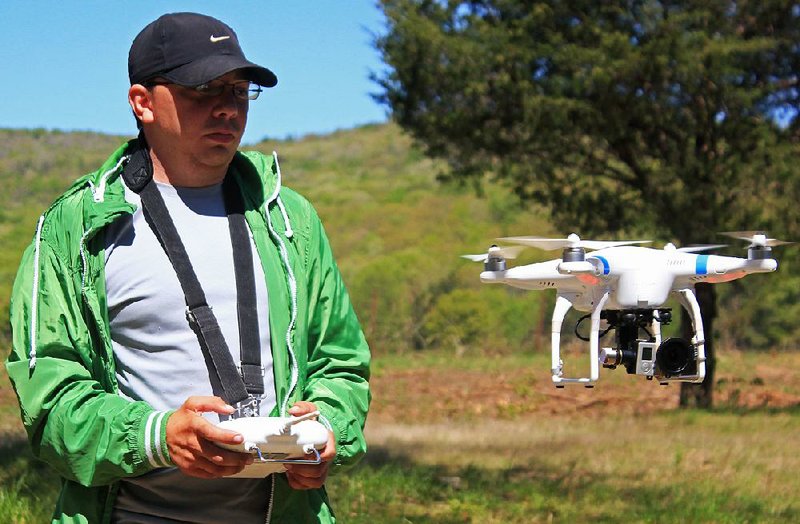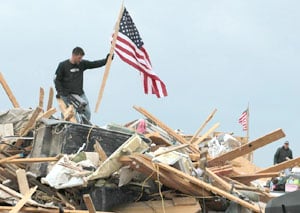Brian Emfinger’s remote controlled flights to capture overhead video of the Arkansas communities ravaged by the April 27 EF4 tornado caught the attention of federal regulators who are developing rules on commercial uses of unmanned aerial vehicles.
RELATED ARTICLES
http://www.arkansas…">Obama due this week at twister siteshttp://www.arkansas…">Priceless pieces strewn for mileshttp://www.arkansas…">Victims of the April 27 tornadoeshttp://www.arkansas…">Volunteers turn out to fill bellies
But Emfinger isn’t letting the scrutiny stop him from continuing to use his device, commonly referred to as a drone.
“We’re going to continue to do what we are doing,” the photojournalist for KATV,Channel 7, said.
Emfinger’s footage, which showed destroyed houses and other debris in Mayflower moments after the tornado hit, provided one of the earliest visuals of the damage left by the storm. In the past week, the video has garnered more than 2 million views on YouTube.
However, the Federal Aviation Administration currently prohibits the commercial use of unmanned aircraft.
On Tuesday, the agency notified KATV that Emfinger’s drone had popped up on their radar, said Nick Genty, the station’s news director.
Genty said a representative of the FAA told the station that it “believes the use of the drone, in their opinion, was used for commercial purposes.”
“Basically making me aware that they had seen the footage and that was their opinion,” he said, adding the agency gave no indication that it might take action.
However, Genty said he does not believe Emfinger’s unmanned aerial vehicle constituted a commercial use. Emfinger, an employee of KATV, owns the drone, not the station, Genty said.
“We don’t pay for the use of the drone,” he said. “Therefore we’re not paying [Emfinger] or anyone else for the footage they capture.”
On Wednesday, the FAA said in a statement that it was “looking into” Emfinger’s drone use and that it was “aware of the possible use of [unmanned aircraft] during and after the tornado coverage and we are looking into it. It’s among several entities, not just a single one.”
The agency’s interest was sparked when the Arkansas Democrat-Gazette reported on television stations using drones in their coverage of the aftermath of the tornado. Several news organizations, including the Democrat-Gazette, showed the KATV footage on their own websites after it was shared by The Associated Press.
KATV has continued to use Emfinger’s white drone, which is about a foot and a half wide with propellers that are about 8 inches long, throughout the week to capture more footage for its broadcasts, Genty said.
Genty said that before Emfinger sends his vehicle aloft to take video, the two men discuss how it would benefit the station’s news coverage.
“It’s his choice when and where he uses it,” Genty said. “He just let’s me know when he’s going to fly it.”
Genty added, “If it serves a purpose we will fly it. If the opportunity presents itself we will probably continue to fly it.”
Genty said Emfinger’s vehicle provides a different perspective to news coverage and informing viewers. “[We] want to make sure it serves that purpose and not using it because it’s cool,” he said.
The debate surrounding the use of drones by KATV and other television stations in their tornado coverage is just one example of the dispute between the FAA and users of the device over regulation.
While the FAA says it doesn’t allow the commercial use of unmanned aircraft, some users of the devices contend that a recent court case nullifies the agency’s jurisdiction over them.
In March, a federal judge dismissed a case against Raphael Pirker after the FAA fined Pirker for using an unmanned aircraft to shoot a promotional video. The judge said the agency didn’t have jurisdiction over drones when it imposed the fine. The ruling was put on hold after the FAA appealed the decision.
Brendan Schulman, Pirker’s lawyer, said that there is no regulation that specifically addresses the use of a drone, but that the FAA has said in a “policy statement” that the business use of the aircraft is prohibited.
“The use of drone by a news organization raises some very big First Amendment questions that are largely being overlooked,” he said. “If the agency’s policy is to allow recreational photography but disallows photography that has news value to the public there ought to be a concern about First Amendment rights and freedom of the press.”
The FAA said Thursday that it “can and does take enforcement against careless and reckless operation of an aircraft whether manned or unmanned.”
“The FAA does not regulate the publication of footage shot with [an unmanned aircraft],” the agency said. “Rather, the FAA’s authority covers the operation of the [unmanned aircraft] used to obtain the footage. If a TV station contracts with an operator to shoot video using [an unmanned aircraft] the station may be assuming operational control of the operation, which would make it subject to FAA regulations.”
The agency said that under the FAA Modernization and Reform Act of 2012 unmanned aircraft are subject to regulation from the agency.
Federal rules do allow civilian users to fly unmanned vehicles if they and the aircraft have the proper certification. However, hobbyists who fly drones for recreational reasons below 400 feet are not required to have federal approval, according to the FAA’s website.
The FAA defines a commercial operator of a drone as: “… a person who, for compensation or hire, engages in the carriage by aircraft in air commerce of persons or property.”
The FAA is updating its regulations for commercial use of drones after Congress in 2012 ordered the agency to craft rules to safely expand military, commercial and privately owned drones’ access to airspace in 2015. The agency said it plans to publish the proposed rules for public comment later this year.
The U.S. Senate Committee on Commerce, Science and Transportation addressed the issue of unmanned aerial vehicles during a hearing in January.
U.S. Sen. Mark Pryor, DArk., who serves on the committee, said, “I will continue to monitor the FAA’s progress to ensure that they strike the right balance between protecting Americans’ privacy and safety and functionality.”
The photographers who fly drones say they aren’t opposed to new FAA regulations. In fact, they said, guidelines are needed to help keep the airspace and people on the ground safe when the aircraft are used.
“Something has to change because there’s a greater good here,” said Bill Allen, a professor who teaches a small drone class at the Missouri School of Journalism at the University of Missouri. “There has to be a way to allow people up there to do those kind of images that keeps these drones out of aircraft engines that are flying higher.”
Emfinger wasn’t the only photographer to use a drone to capture footage of the tornado damage last week.
Tim Trieschmann, owner of The Shot Above, a company that specializes in aerial photography, used an unmanned aerial vehicle to film overhead video of the tornado damage in Mayflower and Vilonia during the week.
He said that one day when he was in Mayflower shooting video with one of his drones, four different unmanned aircraft were buzzing around - an unusual sight.
“I think the times are changing,” Trieschmann said, adding that the inexpensiveness of the devices - one can be bought for less than $1,000 - makes it easy for a person to acquire.
On Thursday, Trieschmann declined to say who his clients were, saying he wanted to keep them confidential. Earlier in the week, he told the Democrat-Gazette that he was filming aerial video for KLRT-TV, Channel 16. KLRT’s news director did not return phone calls or emails for this story.
“Certainly everybody is using it - and for commercial reasons,” Emfinger said. “There’s nobody saying that this wasn’t a good thing.”
Matt Waite, a professor who leads the Drone Journalism Lab for the College of Journalism and Mass Communications at the University of Nebraska-Lincoln, said that he is worried that the use of unmanned aerial vehicles by televisions stations could backfire as there are no current guidelines in place.
“I think it’s both the promise and the peril,” he said. “There’s no set of guidelines that say this is what safe operation is. Until we have those it’s a real concern.”
Waite’s Drone Journalism Lab, which is working to get a certificate of authorization, pays students to work with small drones that are flown indoors. The drones are being flown inside because the lab received a cease and desist letter from the FAA. Waite was a reporter for the Democrat-Gazette during the late 1990s.
“Events like this show the clear value of these devices and the material that can come off of them,” Waite said. “We are just in a weird regulatory spot right now.”
Business, Pages 75 on 05/04/2014

